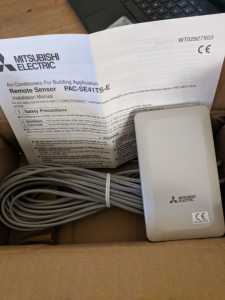Posted by: @adaml
Thank you for getting back.
Does a formula exist to calculate the flow temp for a given outside temp? For example, what would the flow be at an outdoor temp of 8°C with a curve of X? I seem to remember you posted a formula some time ago, I cannot find it though.
Hi Adam,
It is quite simple.
If the upper and lower outdoor air temperature settings are say -10C and 15C, then the overall range is 25C.
If the water flow temperature settings are 40C at -10C and 20C at 15C, then the overall difference is 20C.
So the formula would be :-
(40C - 20C) divided by (15C - (-10C)) = 0.8
At an outdoor air temperature of say 8C, then the calculation would be (15C - 8C) x 0.8 + 20C = 25.6C
I hope this makes sense.
Hi all, just a quick post in between the building work & decorating that we've got going on currently. I have been speaking with the Mitsubishi Ecodan ASHP official Help Desk quite often recently, and their technicians have been very forthcoming about the impact of the various settings on their ASHP systems. For a short while, I had mine set to room thermostat, until I spoke to the techie & he said "Whooah, you don't want to be doing that. That'll be costing you, you should switch it over to Weather Compensation!". It turns out, from my own experiences, that this is how my Ecodan runs:
Weather Compensation - warm house, least expensive to run
Constant Flow - warm house, noticeably more expensive to run
Room Thermostat - warm house, excruciatingly expensive to run
However, there is a "new" thing that we haven't discussed yet, as far as I'm aware. The ASHP manufacturers always refer to it as the Weather Compensation Curve, but so far, we seem to have been working with straight lines...! We have a top flow temperature of 45°C, a lower flow temp of 20°C and a straight line running between them! However, I have discovered that my own system is nowhere near linear. Yes, my house is lovely and warm when it's -1°C outside, but it was too hot inside when it was 5°C outside, and too cold inside when it was when it was 8°C outside. On my Ecodan, it allows you to "tweak" the curve. This makes it a bit bumpy, but allows you to put in what ends up looking like steps - the same flow rate for 2°C or 3°C difference outside, then drop it down again. I have been playing with this for a little while, & will report back when I have enough experiences to say if it helps - & what effects it has both on warmness & cost.
Posted by: @justinsbHi all, just a quick post in between the building work & decorating that we've got going on currently. I have been speaking with the Mitsubishi Ecodan ASHP official Help Desk quite often recently, and their technicians have been very forthcoming about the impact of the various settings on their ASHP systems. For a short while, I had mine set to room thermostat, until I spoke to the techie & he said "Whooah, you don't want to be doing that. That'll be costing you, you should switch it over to Weather Compensation!". It turns out, from my own experiences, that this is how my Ecodan runs:
Weather Compensation - warm house, least expensive to run
Constant Flow - warm house, noticeably more expensive to run
Room Thermostat - warm house, excruciatingly expensive to runHowever, there is a "new" thing that we haven't discussed yet, as far as I'm aware. The ASHP manufacturers always refer to it as the Weather Compensation Curve, but so far, we seem to have been working with straight lines...! We have a top flow temperature of 45°C, a lower flow temp of 20°C and a straight line running between them! However, I have discovered that my own system is nowhere near linear. Yes, my house is lovely and warm when it's -1°C outside, but it was too hot inside when it was 5°C outside, and too cold inside when it was when it was 8°C outside. On my Ecodan, it allows you to "tweak" the curve. This makes it a bit bumpy, but allows you to put in what ends up looking like steps - the same flow rate for 2°C or 3°C difference outside, then drop it down again. I have been playing with this for a little while, & will report back when I have enough experiences to say if it helps - & what effects it has both on warmness & cost.
@justinb
I have an Ecodan running on weather comp so will be very interested to see updates and explanation of this ‘stepping’ process. Never heard of it.
Retrofitted 11.2kw Mitsubishi Ecodan to new radiators commissioned November 2021.
14 x 500w Monocrystalline solar panels.
2 ESS Smile G3 10.1 batteries.
ESS Smile G3 5kw inverter.
@morgan if you look at your Weather Compensation curve, you will see that the flow temp mostly drops 1°C for every 1°C drop in outside temp - giving you a straight line. Compare this with the Constant Flow Temp, where the Flow Temp is always 45°C, & it turns the system on or off when needed. What I'm talking about is running a Flow Temp of (say) 45°C below 0°C outside, then 44°C between 1°C and 2°C outside, then 43°C between 3°C and 4°C outside. That sort of thing. I believe that we have a lot of scope for flexibility when the temp goes above say 15°C outside, but may need to give things a bit more oomph at certain points when it is colder - as my house looses more heat in certain heat ranges than in others.
Posted by: @justinsb@morgan if you look at your Weather Compensation curve, you will see that the flow temp mostly drops 1°C for every 1°C drop in outside temp - giving you a straight line. Compare this with the Constant Flow Temp, where the Flow Temp is always 45°C, & it turns the system on or off when needed. What I'm talking about is running a Flow Temp of (say) 45°C below 0°C outside, then 44°C between 1°C and 2°C outside, then 43°C between 3°C and 4°C outside. That sort of thing. I believe that we have a lot of scope for flexibility when the temp goes above say 15°C outside, but may need to give things a bit more oomph at certain points when it is colder - as my house looses more heat in certain heat ranges than in others.
Hi Justin,
I don't wish to decry the results of your testing, but I would just like to offer a few words of caution.
My control system maintains the indoor air temperature at a constant 21C +/- 0.1C, so it therefore allows me to see the effect of outside influences in a fairly controlled manner. As you have correctly stated, to maintain a constant indoor temperature, it is necessary to vary the water flow temperature as the outdoor air temperature varies. Whilst weather compensation, based on measuring the outdoor air temperature, is quite successful at maintaining a reasonably constant indoor air temperature, it fails to take account of solar gain, wind chill and the cooling effect of rain.
Monitoring my own system has shown that even on cloudy days, when the outdoor air temperature has been constant, the solar gain absorbed by the fabric of the building has been sufficient to lower the required water flow temperature by several degrees. Conversely, on windy and/or rainy days, again with a constant outside air temperature, the required water flow temperature was increased by several degrees.
For a quite constant indoor air temperature, the control system should use the manufacturers indoor air temperature sensor, in conjunction with correctly adjusted weather compensation.
Posted by: @justinsbHi all, just a quick post in between the building work & decorating that we've got going on currently. I have been speaking with the Mitsubishi Ecodan ASHP official Help Desk quite often recently, and their technicians have been very forthcoming about the impact of the various settings on their ASHP systems. For a short while, I had mine set to room thermostat, until I spoke to the techie & he said "Whooah, you don't want to be doing that. That'll be costing you, you should switch it over to Weather Compensation!". It turns out, from my own experiences, that this is how my Ecodan runs:
Weather Compensation - warm house, least expensive to run
Constant Flow - warm house, noticeably more expensive to run
Room Thermostat - warm house, excruciatingly expensive to runHowever, there is a "new" thing that we haven't discussed yet, as far as I'm aware. The ASHP manufacturers always refer to it as the Weather Compensation Curve, but so far, we seem to have been working with straight lines...! We have a top flow temperature of 45°C, a lower flow temp of 20°C and a straight line running between them! However, I have discovered that my own system is nowhere near linear. Yes, my house is lovely and warm when it's -1°C outside, but it was too hot inside when it was 5°C outside, and too cold inside when it was when it was 8°C outside. On my Ecodan, it allows you to "tweak" the curve. This makes it a bit bumpy, but allows you to put in what ends up looking like steps - the same flow rate for 2°C or 3°C difference outside, then drop it down again. I have been playing with this for a little while, & will report back when I have enough experiences to say if it helps - & what effects it has both on warmness & cost.
I'd be very interested to hear how this goes. When you say 'Room Thermostat' do you have the Mitsubishi one (i.e so that Auto Adaptation is used) or an external one?
I have found same but the discrepancy is only 1 degree or so so I just live with it.
Room Thermostat is a non-Mitsubishi one.
I'll see how this all goes & keep you posted. As with all things ASHP-related, it's an interesting learning curve & I find out more about how this system runs with every passing day. I noticed those symptoms in the first couple of weeks running it, so I'm interested to see if what effect a minor curve tweak will have on them.
Derek,
yes, wrong choice of words. The reason I was asking is I now have this (£16.99 new off Ebay) which would allow me to use the wired in controller in the airing cupboard in auto adaptation mode. It looks quite straightforward to install.
@alec-morrow @derek-m Why do you think an installer would have set my weather dependant heat curve to a flat line ? Is that just to make things easier for everyone ? I have 'weather dependant' set, but the curve is just a straight line ! so the LWT is the same whatever the outside temperature.
Posted by: @heat-pump-newbie@alec-morrow @derek-m Why do you think an installer would have set my weather dependant heat curve to a flat line ? Is that just to make things easier for everyone ? I have 'weather dependant' set, but the curve is just a straight line ! so the LWT is the same whatever the outside temperature.
Hi Newbie,
The answer is probably quite simple, I suspect that they have set at 45C or maybe 50C, so that your radiators always feel warm to the touch and you are less likely to call them back and complain. A further important reason is that they don't have to pay your electricity bill.
- 26 Forums
- 2,364 Topics
- 53.6 K Posts
- 873 Online
- 6,029 Members
Join Us!
Worth Watching
Latest Posts
-

How long will your energy contract last?
Some heat pump tariffs don’t run as long as a heat pu...
By Toodles , 5 hours ago
-

@morgan They are unsupervised these days, can’t get the...
By Toodles , 5 hours ago
-
-
RE: Octopus Cosy Heat Pump Owners & Discussion Thread
@kevh it's worth remembering that many lsvs only actual...
By JamesPa , 1 day ago
-

RE: Setback savings - fact or fiction?
Exactly. We only need to compare conditions, to decide ...
By cathodeRay , 1 day ago
-
RE: Balancing financial efficiency and comfort using the Octopus Cosy tariff
I found because I have very low heat loss I can set bac...
By RadWhisperer , 2 days ago
-
RE: Need Help Optimising My Rushed ECO4 Install: 12kW Bosch Heat Pump
Welcome @mickamills We too have an oversized 12kW Sa...
By Old_Scientist , 2 days ago
-
RE: My Powerwall 3 Consumes 3-4 kWh/Day in Self-Consumption: Is This Normal?
@caron I can confirm that the power usage of the PW3 is...
By Old_Scientist , 2 days ago
-
RE: Speedcomfort radiator fans
Thats true, but having tried (and succeeded) in constru...
By JamesPa , 2 days ago
-
RE: Solis S6-EH1P8K-L-PLUS – Why I Chose It and What I’ve Learned So Far
@bash brilliant, thanks for the feedback
By energy9165 , 2 days ago
-

RE: Heat Pump Heats the House… But It’s Not Cosy. Emitter Changes or System Tweak?
@alastair There I was, feeling grumpy, he said “Cheer u...
By Toodles , 2 days ago
-
RE: Grant Aerona: Is there a setting to keep the 2-port valve open during pump blockade
Depends on OAT. Mine cycles at OAT>10 and of course...
By JamesPa , 2 days ago
-
RE: New Fogstar 15.5kWh upright solution
@transparent My conclusion is as you have noted, tha...
By Bash , 2 days ago
-
RE: Mitsubishi Ecodan R290 10kW performance
And to you too. Wishing you a very enjoyable festive s...
By Sheriff Fatman , 2 days ago
-

RE: External pipework insulation
They do? But that isn't apparent from the photos we'r...
By Transparent , 2 days ago
-

RE: Say hello and introduce yourself
@velcro welcome to the forums. Please feel free start a...
By Mars , 3 days ago
-
Daikin EDLA11D3V3 DHW Settings
I have a newly installed EDLA11D3V3 which I'm still get...
By Velcro , 3 days ago
-
RE: Midea ASHP – how to set weather compensation
@curlykatie did you get sorted with this?
By MickaMills , 3 days ago
-
RE: MyVaillant Connect Regular Disconnect
Thanks. Yes, if the time is consistently 11pm every nig...
By buckwem , 4 days ago




